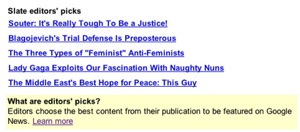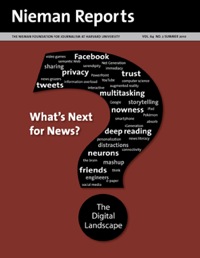[Every Friday, Mark Coddington sums up the week’s top stories about the future of news and the debates that grew up around them. —Josh]
![]() The FTC’s last round of input: The U.S. Federal Trade Commission wrapped up its series of forums on journalism and public policy Tuesday, and this forum got quite a bit more attention than the others — partly because it’s the last one, and partly because the FTC released its draft of possible policy proposals a few weeks ago, which gave people something concrete to pick apart.
The FTC’s last round of input: The U.S. Federal Trade Commission wrapped up its series of forums on journalism and public policy Tuesday, and this forum got quite a bit more attention than the others — partly because it’s the last one, and partly because the FTC released its draft of possible policy proposals a few weeks ago, which gave people something concrete to pick apart.
 Before the forum, The New York Times’ Jeremy Peters and TBD’s Steve Buttry both gave good summaries of what various people are saying about the issue, and Save the News’ Fiona Morgan gave a helpful, detailed description of what went on at the forum itself. As for the FTC’s final report due out this fall, Poynter’s Rick Edmonds and Bloomberg Businessweek’s Olga Kharif both wrote that we’re unlikely to see any proposals for significant government intervention in the news business. Edmonds offers a handful of reasons that the idea has fallen out of favor: Newspapers’ financial fortunes have improved lately, we’ve seen an explosion of strongly backed digital journalism experiments, the government might not be able to do it well, and news organizations themselves aren’t sure what they want from Uncle Sam. Both Edmonds and Kharif also noted that Congress won’t be willing to be seen as bailing out another for-profit industry.
Before the forum, The New York Times’ Jeremy Peters and TBD’s Steve Buttry both gave good summaries of what various people are saying about the issue, and Save the News’ Fiona Morgan gave a helpful, detailed description of what went on at the forum itself. As for the FTC’s final report due out this fall, Poynter’s Rick Edmonds and Bloomberg Businessweek’s Olga Kharif both wrote that we’re unlikely to see any proposals for significant government intervention in the news business. Edmonds offers a handful of reasons that the idea has fallen out of favor: Newspapers’ financial fortunes have improved lately, we’ve seen an explosion of strongly backed digital journalism experiments, the government might not be able to do it well, and news organizations themselves aren’t sure what they want from Uncle Sam. Both Edmonds and Kharif also noted that Congress won’t be willing to be seen as bailing out another for-profit industry.
A few more voices — media economics professor Robert Picard, TBD’s Mandy Jenkins and conservative Denver Post columnist David Harsanyi — joined the anti-subsidy chorus this week, and the Times’ Eric Pfanner provided some evidence to back them up, pointing out that countries with the largest direct subsidies for newspapers also have the lowest newspaper readership. (He also noted the U.S. media’s extreme reliance on advertising compared with the rest of the world.)
Other folks offered a few ideas of what policy proposals they’d like to see the FTC endorse. Edmonds wants to see nonprofits allowed to accept advertising, j-prof C.W. Anderson says public policy has a role in “fostering an entrepreneurial, innovative, reinvented journalistic sphere,” Salon’s Dan Gillmor stumps for open broadband subsidies, and Save the News’ Josh Stearns lists five ideas he wants endorsed. The themes that run across several of those people’s proposals are clear: Net neutrality, expanded broadband, open government data, and encouragement for innovation, rather than protection for traditional media businesses.
Google News goes human: One low-key but potentially significant development from late last week: As the Lab’s Megan Garber reported, Google News began an experiment called Editors’ Picks, in which editors from partner news organizations like the BBC and the Washington Post curate lists of news articles to go along with Google’s algorithm-run selections. Garber notes what a shift this is from Google’s historical approach to news aggregation and ties it to the quest for serendipity: “This is one way of replicating the offline experience of serendipity-via-bundling within the sometimes scattered experience of online news consumption,” she says.
 GigaOM’s Mathew Ingram saw in the project a similar sign of a shift toward human-powered news aggregation at Google, though he noted that Google has tried numerous news-related experiments that never caught on. That’s exactly what a Google spokesperson told paidContent’s Staci Kramer, and both sites mentioned Google’s ill-fated commenting experiment as an example.
GigaOM’s Mathew Ingram saw in the project a similar sign of a shift toward human-powered news aggregation at Google, though he noted that Google has tried numerous news-related experiments that never caught on. That’s exactly what a Google spokesperson told paidContent’s Staci Kramer, and both sites mentioned Google’s ill-fated commenting experiment as an example.
Still, Mashable’s Vadim Lavrusik loved this idea, making a case for the value of human editors in making sure that people are reading what they need to know online as well as what they want to know. In other Google News news, its creator, Krishna Bharat, gave a long interview in which he discussed its role in journalism and his idea of what the future of journalism might look like.
A theory of the political press defined: If you’ve been following NYU professor Jay Rosen on Twitter or reading his blog for any length of time, you’ve probably absorbed a general sense of his guiding philosophy about the American political press. But this week he posted the definitive explanation of that philosophy, which is most simply that political journalists’ prevailing ideology is one of false equivalency between two sides of political extremists, while they (and their favorite politicians) stand at the sane, savvy, skeptical center. It’s one critic’s opinion, but it’s a remarkably helpful frame to help interpret what the Washington press corps values and why it does what it does.
There’s some fascinating discussion about Rosen’s ideas in the lengthy comments of his post, and he got a few thoughtful responses elsewhere, as well. The Atlantic’s Conor Friedersdorf agreed with the main thrust of Rosen’s argument, though he challenged the assertion that political journalists are “big believers in the law of unintended consequences” who don’t pay much attention to the direct consequences of public policy. The Economist likewise endorses the post but counters that Rosen’s concepts of “he said, she said journalism” and “the sphere of deviance” are at odds. Over at Slate, Tom Scocca affirms a point of Rosen’s about journalists’ disregard for street protests, and Australian journalist Jonathan Holmes adapted the concept to the Australian media.
Also, the Atlantic’s Marc Ambinder — as a political editor, part of the tribe Rosen was dissecting — asked the professor what he would have the political press think instead. Rosen has promised an answer.
Murdoch picks up some paid-content pieces: Rupert Murdoch’s News Corp. continued its long, steady march toward a paid-news future with a few small but potentially important moves this week: It bought the Skiff mobile software platform from the newspaper chain Hearst — not the Skiff e-reader itself, though it seems they’re working on that — invested in Journalism Online, Steve Brill’s news paid-content venture, and bid to take full control of British Sky Broadcasting, Europe’s largest for-pay broadcaster.
Hollywood Reporter’s Andrew Wallenstein called the first two moves huge news for the digital news business, arguing that Murdoch is setting the standard for the way everyone else does business online. “This is about laying the groundwork for the very process by which people pay for that news; namely, the device they consume it on and the virtual storefront that handles the payment,” he wrote. And with BSkyB’s digital music and broadband services, it looks like Murdoch’s hoping to add another major asset in his plans to find new ways to get people to pay for not only news, but digital entertainment media as well.
 Future-of-news thoughts and innovation: Before we get to the reading roundup, a note on a couple of interesting items that the Lab has been highlighting this week. First, our sister publication, Nieman Reports, has published its quarterly issue, which is full of thought-provoking essays on journalism in transition. This issue is titled “What’s Next for News?” so it’s right along the lines of the stuff we write about here at the Lab. The Lab has been pointing out several of the issue’s 36 pieces — including thoughts on the Internet’s effects on our thinking, the editor-as-gatekeeper role, and the semantic web — but there’s plenty more out there, so go look around.
Future-of-news thoughts and innovation: Before we get to the reading roundup, a note on a couple of interesting items that the Lab has been highlighting this week. First, our sister publication, Nieman Reports, has published its quarterly issue, which is full of thought-provoking essays on journalism in transition. This issue is titled “What’s Next for News?” so it’s right along the lines of the stuff we write about here at the Lab. The Lab has been pointing out several of the issue’s 36 pieces — including thoughts on the Internet’s effects on our thinking, the editor-as-gatekeeper role, and the semantic web — but there’s plenty more out there, so go look around.
Second, the Knight News Challenge announced the 12 winners of its $2.74 million worth of grants for innovative journalism projects. The Lab’s Joshua Benton has a rundown of the winners and a few observations about the crop as a whole, and we’ve got profiles of a few of the initiatives, too. There’s Stroome, the wiki-style collaborative video-editing site; Public Radio Exchange, a crowdfunding project for public radio journalism; The Cartoonist, a project to allow easy building of editorial-cartoon-like games; and Order in the Court 2.0, an effort to open up courtrooms through new media. They should have several more profiles up over the next few days (probably even before this post is published) if you’re in the mood to be encouraged by innovation in news.
Reading roundup: Two ongoing discussions, one news economics development, and one thoughtful piece on context:
— Two news economics experts, Alan Mutter and Frederic Filloux, weighed in this week with their assessments of iPad news apps so far. Mutter looks at the winners and losers, and Filloux talks about what makes iPad news apps work.
— We’ve been hearing for a couple of weeks about what the Internet is (or isn’t) doing to our brains, and that conversation continued with a defense of the web by The New York Times’ Nick Bilton a caution to doomsayers by psychology professor Steven Pinker.
— Consulting firm PricewaterhouseCoopers estimated this week that Internet ad revenue will surpass newspaper ad revenue by 2014. Both will still remain behind TV ad revenue, they said.)
— Finally, former journalist John Zhu wrote a wonderful explanation of the state of, well, explanation in the news. (Complete with helpful visual aids!) If you’re interested at all in how journalists can make complex stories more understandable to people, this is the perfect place to start putting together where we’ve been and where we could be going.